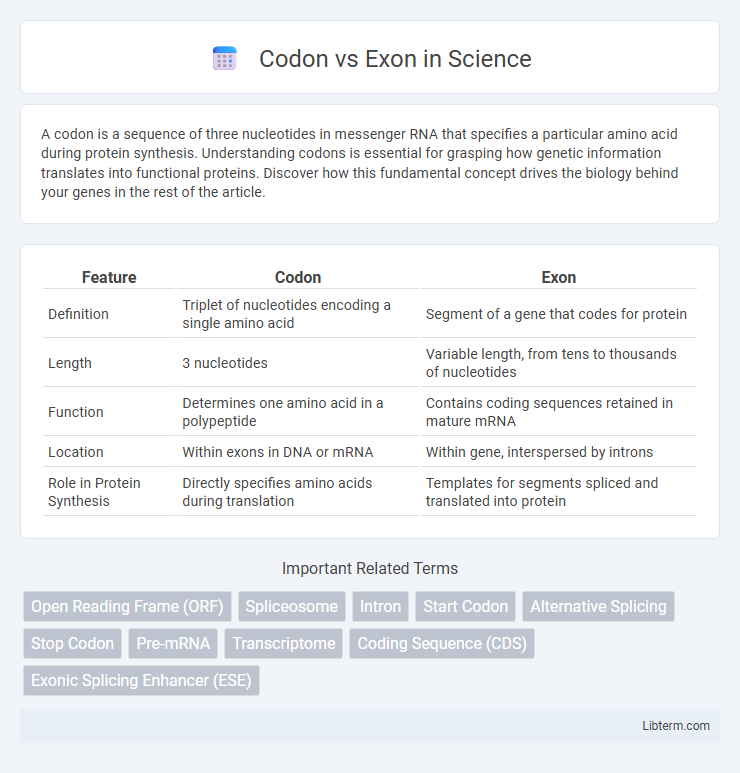A codon is a sequence of three nucleotides in messenger RNA that specifies a particular amino acid during protein synthesis. Understanding codons is essential for grasping how genetic information translates into functional proteins. Discover how this fundamental concept drives the biology behind your genes in the rest of the article.
Table of Comparison
| Feature | Codon | Exon |
|---|---|---|
| Definition | Triplet of nucleotides encoding a single amino acid | Segment of a gene that codes for protein |
| Length | 3 nucleotides | Variable length, from tens to thousands of nucleotides |
| Function | Determines one amino acid in a polypeptide | Contains coding sequences retained in mature mRNA |
| Location | Within exons in DNA or mRNA | Within gene, interspersed by introns |
| Role in Protein Synthesis | Directly specifies amino acids during translation | Templates for segments spliced and translated into protein |
Introduction to Codons and Exons
Codons are triplets of nucleotides in messenger RNA (mRNA) that specify particular amino acids during protein synthesis, forming the genetic code's fundamental units. Exons are sequences within a gene that remain in the mature mRNA after splicing, encoding the amino acid sequence of a protein. Together, codons within exons determine the precise assembly of proteins essential for cellular function.
Defining Codons: The Building Blocks of Genetic Code
Codons are triplets of nucleotides within mRNA that specify particular amino acids during protein synthesis, serving as the fundamental units of the genetic code. Each codon corresponds to a specific amino acid or a stop signal, enabling the translation of genetic information into functional proteins. Unlike exons, which represent coding sequences in DNA that remain after RNA splicing, codons operate at the mRNA level to direct amino acid assembly in ribosomes.
Understanding Exons: Structure and Function
Exons are sequences within a gene that encode the amino acid sequence of proteins, playing a critical role in determining protein structure and function. Unlike codons, which are triplets of nucleotides specifying individual amino acids during translation, exons represent the contiguous segments of DNA that remain after RNA splicing and are joined to form the mature messenger RNA (mRNA). Exons contribute directly to the genetic blueprint for protein synthesis, whereas codons are functional units within exons that guide ribosomes in assembling proteins.
Key Differences Between Codons and Exons
Codons are triplets of nucleotides within mRNA that specify individual amino acids during protein synthesis, while exons are sequences of DNA or RNA that code for portions of the final mature RNA product, such as mRNA. Codons function at the translation level as units of genetic code read by the ribosome, whereas exons represent the coding segments retained after RNA splicing that contribute to the gene's coding sequence. The primary difference lies in codons being functional units of the genetic code, and exons being structural units of genes that include multiple codons.
Biological Roles of Codons in Protein Synthesis
Codons are triplets of nucleotides in messenger RNA (mRNA) that specify amino acids during protein synthesis, serving as the fundamental units of the genetic code. Each codon corresponds to a particular amino acid or a stop signal, directing ribosomes to assemble amino acids into polypeptide chains. In contrast, exons are sequences within a gene that remain in the mature mRNA after splicing, encoding the actual protein sequence and ensuring the correct translation of codons into functional proteins.
The Function of Exons in Gene Expression
Exons play a crucial role in gene expression by encoding the amino acid sequences that form functional proteins, with their sequences directly determining protein structure and function. Unlike codons, which are triplets of nucleotides within both exons and introns that specify individual amino acids during translation, exons collectively carry the genetic information required for producing mature messenger RNA (mRNA) after intron splicing. This precise removal of introns and ligation of exons enable the synthesis of proteins that drive cellular processes and phenotypic traits.
Codons vs Exons: Genomic Locations Explained
Codons are sequences of three nucleotides within exons that directly code for amino acids during protein synthesis. Exons are the expressed regions of a gene, encompassing multiple codons, and are located in the genomic DNA segments transcribed and spliced to form mature mRNA. Understanding genomic locations reveals that codons exist exclusively within exons, whereas introns separate exons, highlighting the functional distinction between coding sequences and non-coding genomic regions.
Mutations: Impact on Codons and Exons
Mutations in codons can alter the amino acid sequence by changing a single nucleotide triplet, potentially leading to missense, nonsense, or silent mutations with direct effects on protein structure and function. Exon mutations may affect entire coding regions, causing frameshifts, splice site alterations, or exon skipping, which can drastically impact gene expression and result in dysfunctional or truncated proteins. Both codon-level and exon-level mutations contribute significantly to genetic diseases by disrupting the precise instructions required for protein synthesis.
Codon and Exon Relevance in Genetic Disorders
Codons are triplet sequences of nucleotides in mRNA that specify amino acids during protein synthesis, while exons are coding regions within genes that are transcribed and spliced to form mature mRNA. Mutations in codons, such as point mutations or nonsense mutations, can lead to altered or truncated proteins causing genetic disorders like cystic fibrosis or sickle cell anemia. Exon skipping or mutations disrupting exon structure can result in improper mRNA splicing, contributing to diseases such as Duchenne muscular dystrophy, highlighting the critical relevance of both codons and exons in genetic pathology.
Summary: Comparing Codons and Exons in Molecular Biology
Codons are triplets of nucleotides in mRNA that specify amino acids during protein synthesis, playing a crucial role in translating genetic information into functional proteins. Exons are segments of DNA or RNA that code for protein sequences and are spliced together during mRNA processing to form the mature messenger RNA. While codons represent the fundamental units of the genetic code, exons are structural regions within genes that contribute to the final protein product.
Codon Infographic

 libterm.com
libterm.com